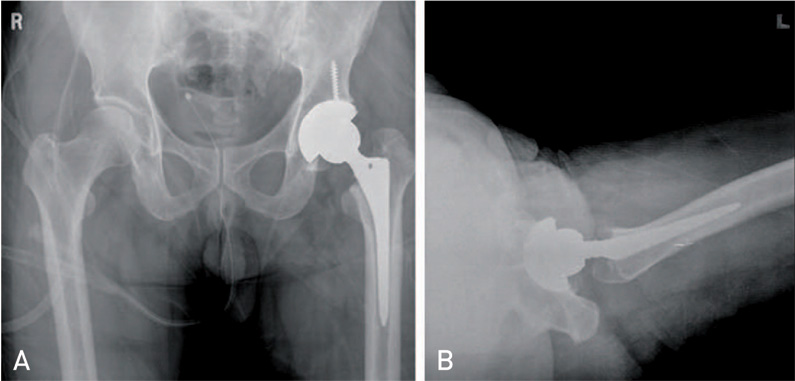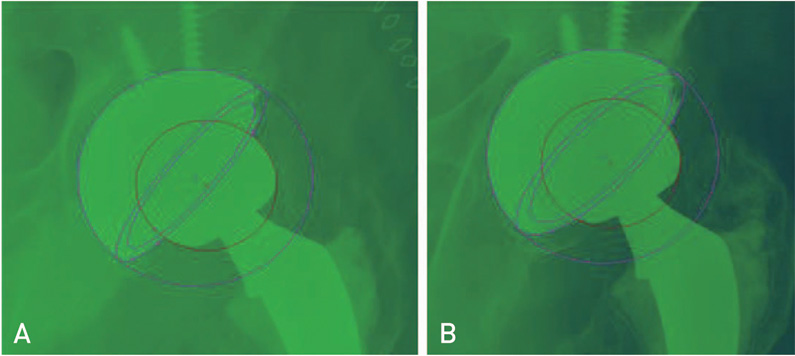Hip Pelvis.
2014 Dec;26(4):220-226. 10.5371/hp.2014.26.4.220.
Results of Primary Total Hip Arthroplasty with 36-mm Femoral Heads on Highly Cross-linked Polyethylene-Minimum Seven-years Follow-up
- Affiliations
-
- 1Department of Orthopaedic Surgery, Daegu Catholic University College of Medicine, Daegu, Korea. cmr0426@cu.ac.kr
- KMID: 1907697
- DOI: http://doi.org/10.5371/hp.2014.26.4.220
Abstract
- PURPOSE
We evaluate the clinical and radiographic midterm results of primary total hip arthroplasty (THA) using a 36 mm diameter femoral head on highly cross-linked polyethylene (minimum 7-year follow-up).
MATERIALS AND METHODS
We retrospectively reviewed 73 patients (74 hips) that underwent primary THA with a 36 mm diameter femoral head on highly cross-linked polyethylene between July 2004 and February 2007. Clinical follow-ups included specific measurements like modified Harris hip scores (HHS) and Merle d'Aubigne and Postel score. For radiologic evaluations, together with position of acetabular cup at 6 weeks later of post-operation, we separately calculated the penentrations of femoral heads into polyethylene liners during post-operation and one year later check-ups, and during one year later check-ups and final check-ups.
RESULTS
There were no complications except for one case of dislocation. Average modified HHS at final follow-up was 88+/-7.5 (range, 81-96), and Merle d'Aubigne and Postel scores were more than 15 (range, 15-18). Mean acetabular cup inclination and anteversion were 50.1degrees(range, 35degrees-58degrees) and 23.6degrees(range, 5degrees-38degrees), respectively. Average femoral head penetration during the first postoperative year was 0.071+/-0.034 mm/year, and steady-state wear rate determined using radiographs taken at one-year postoperatively and at latest follow-up was 0.051+/-0.022 mm/year. Average femoral head penetration during entire follow-ups was 0.058+/-0.013 mm/year.
CONCLUSION
Primary THA with a large diameter femoral head on highly cross-linked polyethylene was found to produce the results comparable to previous in vitro laboratory hip simulation studies. And we also find out good scores in terms of patient's functionality.
Keyword
MeSH Terms
Figure
Cited by 1 articles
-
Results of Total Hip Arthroplasty with 36-mm Metallic Femoral Heads on 1st Generation Highly Cross Linked Polyethylene as a Bearing Surface in Less than Forty Year-old Patients: Minimum Ten-year Results
Won Kee Choi, Jae Jung Kim, Myung-Rae Cho
Hip Pelvis. 2017;29(4):223-227. doi: 10.5371/hp.2017.29.4.223.
Reference
-
1. Sikes CV, Lai LP, Schreiber M, Mont MA, Jinnah RH, Seyler TM. Instability after total hip arthroplasty: treatment with large femoral heads vs constrained liners. J Arthroplasty. 2008; 23:7 Suppl. 59–63.2. Rathi P, Pereira GC, Giordani M, Di Cesare PE. The pros and cons of using larger femoral heads in total hip arthroplasty. Am J Orthop (Belle Mead NJ). 2013; 42:E53–E59.3. Burroughs BR, Rubash HE, Harris WH. Femoral head sizes larger than 32 mm against highly cross-linked polyethylene. Clin Orthop Relat Res. 2002; 405:150–157.
Article4. Geller JA, Malchau H, Bragdon C, Greene M, Harris WH, Freiberg AA. Large diameter femoral heads on highly cross-linked polyethylene: minimum 3-year results. Clin Orthop Relat Res. 2006; 447:53–59.5. Park CM, Cho MR, Kim SK, Choo WK, Kwon JB. Femoral head size of 36 mm against highly cross-linked polyethylene in patients younger than 60 years: minimun three years of follow up. J Korean Orthop Assoc. 2012; 47:28–34.
Article6. Engh CA, Bobyn JD, Glassman AH. Porous-coated hip replacement. The factors governing bone ingrowth, stress shielding, and clinical results. J Bone Joint Surg Br. 1987; 69:45–55.
Article7. Barrack RL, Mulroy RD Jr, Harris WH. Improved cementing techniques and femoral component loosening in young patients with hip arthroplasty. A 12-year radiographic review. J Bone Joint Surg Br. 1992; 74:385–389.
Article8. Engh CA, Griffin WL, Marx CL. Cementless acetabular components. J Bone Joint Surg Br. 1990; 72:53–59.
Article9. Kennedy JG, Rogers WB, Soffe KE, Sullivan RJ, Griffen DG, Sheehan LJ. Effect of acetabular component orientation on recurrent dislocation, pelvic osteolysis, polyethylene wear, and component migration. J Arthroplasty. 1998; 13:530–534.
Article10. Widmer KH. A simplified method to determine acetabular cup anteversion from plain radiographs. J Arthroplasty. 2004; 19:387–390.
Article11. Heisel C, Silva M, dela Rosa MA, Schmalzried TP. Short-term in vivo wear of cross-linked polyethylene. J Bone Joint Surg Am. 2004; 86-A:748–751.
Article12. Lachiewicz PF, Heckman DS, Soileau ES, Mangla J, Martell JM. Femoral head size and wear of highly cross-linked polyethylene at 5 to 8 years. Clin Orthop Relat Res. 2009; 467:3290–3296.
Article13. Barrack RL. Dislocation after total hip arthroplasty: implant design and orientation. J Am Acad Orthop Surg. 2003; 11:89–99.
Article14. Kelly NH, Rajadhyaksha AD, Wright TM, Maher SA, Westrich GH. High stress conditions do not increase wear of thin highly crosslinked UHMWPE. Clin Orthop Relat Res. 2010; 468:418–423.
Article15. Bradford L, Kurland R, Sankaran M, Kim H, Pruitt LA, Ries MD. Early failure due to osteolysis associated with contemporary highly cross-linked ultra-high molecular weight polyethylene. A case report. J Bone Joint Surg Am. 2004; 86-A:1051–1056.16. Dowd JE, Sychterz CJ, Young AM, Engh CA. Characterization of long-term femoral-head-penetration rates. Association with and prediction of osteolysis. J Bone Joint Surg Am. 2000; 82-A:1102–1107.17. Estok DM 2nd, Bragdon CR, Plank GR, Huang A, Muratoglu OK, Harris WH. The measurement of creep in ultrahigh molecular weight polyethylene: a comparison of conventional versus highly cross-linked polyethylene. J Arthroplasty. 2005; 20:239–243.18. Stilling M, Larsen K, Andersen NT, Søballe K, Kold S, Rahbek O. The final follow-up plain radiograph is sufficient for clinical evaluation of polyethylene wear in total hip arthroplasty. A study of validity and reliability. Acta Orthop. 2010; 81:570–578.
Article
- Full Text Links
- Actions
-
Cited
- CITED
-
- Close
- Share
- Similar articles
-
- Results of Total Hip Arthroplasty with 36-mm Metallic Femoral Heads on 1st Generation Highly Cross Linked Polyethylene as a Bearing Surface in Less than Forty Year-old Patients: Minimum Ten-year Results
- Results of Primary Total Hip Arthroplasty Using 36 mm Femoral Heads on 1st Generation Highly Cross Linked Polyethylene in Patients 50 Years and Less with Minimum Five Year Follow-up
- A Liner Breakage in Total Hip Arthroplasty after Using 1st Generation Highly Cross Linked Polyethylene Mated against 36-mm Metal Head: A Case Report
- Total Hip Arthroplasty Using Metal Head on a Highly Cross-linked Polyethylene Liner
- Risk Factors of Dislocation Occurring after Acetabular Component Revision




